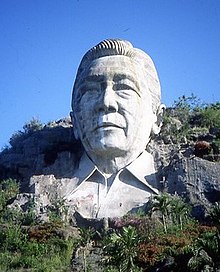Bust of Ferdinand Marcos
The 30-metre (98 ft) concrete bust of Ferdinand Marcos was a monument of President Ferdinand Marcos situated along Aspiras-Palispis Highway, Taloy Sur, Tuba, Benguet, Philippines. The monument became a subject of controversy as its construction displaced indigenous Ibaloi residents in the sparsely populated area, and the land reportedly forced to be sold at very low prices. The monument was destroyed in December 2002, with the Communist Party of the Philippines-New Peoples Army taking credit for its destruction.[1][2]
 The bust in 1989 before its destruction in 2002 | |
.svg.png) Location in Luzon .svg.png) Bust of Ferdinand Marcos (Philippines) | |
| Coordinates | 16°21′13″N 120°29′24″E |
|---|---|
| Location | Mount Shontoug, Aspiras–Palispis Highway, Taloy Sur, Tuba, Benguet, Philippines |
| Material | concrete |
| Height | 30 m (98 ft) |
| Beginning date | 1978 |
| Completion date | 1980 |
| Dedicated to | Ferdinand Marcos |
| Dismantled date | 2002 |
History
Around 1978, the bust's construction began along Marcos Highway. The bust was constructed by the Philippine Tourism Authority and was meant to be the centerpiece of the 300-hectare (740-acre) Marcos Park that would include a golf course, sports club, convention center, and hotel. The bust was positioned near the peak of Mt. Shontoug so it could be seen by Baguio-bound motorists as far as 3 kilometres (1.9 mi) away from the monument. Father and son, Anselmo Dayag Sr. and Anselmo Jr. were chosen to design the bust but the former died due to disease. Scaffolding covered with plywood was reportedly erected to deliberately hide the bust's construction from the public. A typhoon later blew the scaffolding away, exposing the bust. The Ibaloi in the affected area were said to have been displaced due to the bust's construction. It was reported that they were forced to sell their lands for outrageously low prices. The bust was completed around 1980.[4][5][6][7]
After the People Power Revolution of 1986, the Ibaloi peoples slaughtered a pig and carabao and poured the animals' blood into the bust to "exorcise" it and later filed a case to reclaim their land.[4]
The bust was bombed in 1989 by leftist rebels and sustained cracks and other minor damage.[4][7]
The bust was subjected to controversy and was viewed as self-glorification, especially by critics of the Marcos administration. The displaced Ibalois viewed it as a symbol of their mistrust for government authorities since the construction of the bust displaced them from their lands. Communist insurgents also criticized the bust's construction, and many groups planned to destroy the bust.[4]
Destruction
The bust was destroyed using dynamite before dawn on December 29, 2002 by suspected treasure hunters who thought that the bust contained parts of the rumored Yamashita treasure. Benguet Governor Raul Mencio Molintas said that the police learned that a white Toyota FX van was around the area prior to the incident. It was initially thought that the New People's Army was behind the bombing of the monument.[4][5] The rebel group's Chadli Molintas Command claimed responsibility for the incident in a press release a day later. The communists said that the bust's mere existence "is a mockery of justice and a betrayal of the will of the people. ... Let the ruins be an ugly reminder that the Marcoses have yet to pay for their crimes."[7][1]
Some critics of Marcos criticized the destruction of the monument. Archbishop Oscar Cruz of Lingayen-Dagupan said that the perpetrators "should have never destroyed the monument to evil in this country", describing the bust as "a monument to evil, warning people never to become what this man was".[1]
Rehabilitation
In 2003, Baguio city mayor Ramon Labo Jr. made an offer to the Marcos family to restore the bust. Imelda Marcos, the wife of Ferdinand Marcos, treated the offer as a kind gesture, but stated that any move to fix the monument should be a "collective decision of the Marcoses and their supporters". Bongbong Marcos, the son of the former president, said the family did not feel the need to have the bust fixed despite the offer.[5]
References
- "Archbishop decries Marcos bust bombing, Communists take credit". UCA News. 31 December 2002. Retrieved 27 February 2015.
- Dumlao, Artemio (2002-12-30). "Marcos bust blasted". The Philippine Star. Retrieved 2019-02-05.
- "Philippines blast wrecks Marcos bust". BBC News. 29 December 2002. Retrieved 27 February 2015.
- Dumlao, Artemio (30 December 2002). "Marcos bust blasted". The Philippine Star. Pugo, La Union. Retrieved 27 February 2015.
- Arzadon, Cristina (18 January 2003). "Marcos family not keen on busted bust's repair". Philippine Daily Inquirer. Laoag. Retrieved 27 February 2015 – via Google News.
- Cabreza, Vincent (20 September 2011). "Rebuilding a monument for 'Marcos the Man,' not the late dictator". Philippine Daily Inquirer. Retrieved 27 February 2015.
- Cimatu, Frank; Santos-Doctor, Joya (1 January 2003). "Philippines' 'Ozymandias' still haunts". Philippine Daily Inquirer. Retrieved 27 February 2015.